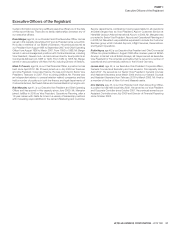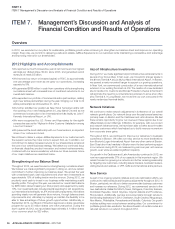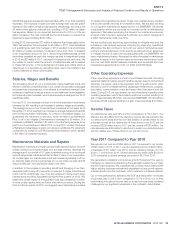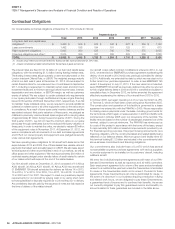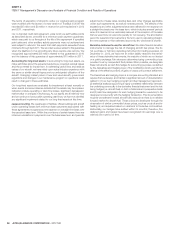JetBlue Airlines 2012 Annual Report Download - page 33
Download and view the complete annual report
Please find page 33 of the 2012 JetBlue Airlines annual report below. You can navigate through the pages in the report by either clicking on the pages listed below, or by using the keyword search tool below to find specific information within the annual report.JETBLUE AIRWAYS CORPORATION-2012 10K 29
PART II
ITEM7Management’s Discussion and Analysis of Financial Condition and Results of Operations
Aircraft fuel expense represented approximately 40% of our total operating
expenses. The increase in year-over-year average fuel cost per gallon
resulted in $20 million of higher fuel expense. Additionally, we consumed
38million more gallons of aircraft fuel, resulting in $122million of higher
fuel expense. Based on our expected fuel volume for 2013, a 10%per
gallon increase in the cost of aircraft fuel would increase our annual fuel
expense by approximately $190 million.
During 2012, we recorded $10 million in effective fuel hedge gains which
offset fuel expense; this compares to $3 million in 2011. Fuel derivatives
not qualifying as cash fl ow hedges in 2012 resulted in approximately
$3 million in losses recorded in interest income and other, compared
to an insignifi cant amount in 2011. Accounting ineffectiveness on fuel
derivatives classifi ed as cash fl ow hedges resulted in insignifi cant losses
in 2012 and $2 million in 2011, recorded in interest income and other. We
are unable to predict what the amount of ineffectiveness will be related
to these instruments, or the potential loss of hedge accounting which is
determined on a derivative-by-derivative basis, due to the volatility in the
forward markets for these commodities.
Salaries, Wages and Benefi ts
The increasing tenure of our Crewmembers, rising healthcare costs and
efforts to maintain competitiveness in our overall compensation packages
are presenting cost pressures. In an attempt to proactively manage future
increases in healthcare costs as a result of new healthcare reform legislation
and impending tax increases, we comprehensively re-designed our 2013
healthcare plans.
During 2012, the average number of full-time equivalent employees
increased by 4% resulting in an increase to salaries, wages and benefi ts.
The average tenure of our Crewmembers increased to 5.6 years as of
December 31, 2012 resulting in an increase to average wages and benefi ts
per full-time equivalent employees. As a result of increased wages, our
guaranteed 5% retirement contribution, which we refer to as Retirement
Plus, to all of our eligible Crewmembers increased by $3 million. Our
increased profi tability resulted in $3 million of profi t sharing expense to be
paid to our Crewmembers in March 2013. During 2012, we also introduced
a Retirement Advantage program, providing an additional 3% retirement
contribution for certain of our FAA-licensed Crewmembers, which resulted
in $4 million of increased expense.
Maintenance Materials and Repairs
Maintenance materials and repairs are generally expensed when incurred
unless covered by a long-term fl ight hour services contract. Because the
average age of our aircraft of 6.7 years is relatively young, all of our aircraft
currently require less maintenance than the fl eet of many of our competitors.
As our fl eet ages, our maintenance costs will increase signifi cantly, both on
an absolute basis and as a percentage of our unit costs, as older aircraft
require additional, more expensive repairs over time.
In addition to the increase in operating aircraft and the aging of our fl eet,
several aircraft coming off of warranty contributed to higher maintenance
costs in 2012. Additionally, one of our key engine and component repair
maintenance providers liquidated during the fi rst quarter of 2012. We
believe the overall impact of the liquidation was approximately $10 million
in more costly repairs while we found alternative providers. During the
third and fourth quarter of 2012, we engaged new maintenance providers
to replace the liquidated provider. These new maintenance providers
will provide similar services at competitive rates. We are also working
on a long-term maintenance agreement for our EMBRAER 190 aircraft
components, which are currently not covered under a maintenance
agreement. We believe expanding the scope of our maintenance services
covered under long-term agreements will help us to better manage and
predict maintenance costs over time.
We are continuously exploring opportunities to mitigate and level the
increase in maintenance expense, including by improving operational
effi ciencies. We also continue to work with our various maintenance repair
partners and manufacturers; most recently we entered into an agreement
to mitigate the risk of cost overruns associated with our EMBRAER 190
heavy maintenance checks. We expect the rate of increase in maintenance
expense to lessen in the next few years as the heavy maintenance hurdle
from our mid-2000 aircraft deliveries subsides and we benefi t from new
maintenance agreements for both our A320 and E190 fl eets.
Other Operating Expenses
Other operating expenses consist of purchased services (including
expenses related to fueling, ground handling, skycap, security and janitorial
services), insurance, personnel expenses, cost of goods sold to other
airlines by LiveTV, professional fees, passenger refreshments, supplies,
bad debts, communication costs and taxes other than payroll and fuel
taxes. During 2012, we had several non-recurring items impacting other
operating expenses. LiveTV terminated a customer contract resulting in a
gain of approximately $8 million. We sold two EMBRAER 190 aircraft and
six spare aircraft engines resulting in a gain of approximately $10 million.
Income Taxes
Our effective tax rate was 39% in 2012 compared to 41% in 2011. Our
effective tax rate differs from the statutory income tax rate primarily due
to state income taxes and the non-deductibility of certain items for tax
purposes as well as the relative size of these items to our 2012 pre-tax
income of $209 million and our 2011 pre-tax income of $145 million. The
rate decrease was attributable to reductions in certain non-deductible items
and the relative size of these items to our pre-tax income.
Year 2011 Compared to Year 2010
We reported net income of $86 million in 2011 compared to net income
of $97 million in 2010. In 2011, we had operating income of $322 million,
a decrease of $11million over 2010, and an operating margin of 7.1%,
down 1.7 points from 2010. Diluted earnings per share were $0.28 for
2011 compared to diluted earnings per share of $0.31 for 2010.
We generated consistent unit revenue growth throughout the year by
managing our network and balancing the seasonality created by our highly
leisure focused business. We complemented our leisure travel markets with
higher yielding business markets and capitalized on key growth regions,
primarily Boston and the Caribbean, which resulted in increased capacity.
Our on-time performance, defi ned by the DOT as arrivals within 14 minutes
of schedule, was 73.3% in 2011 compared to 75.7% in 2010. Our on-time
performance throughout the year and on a year-over-year basis remained
challenged by our signifi cant operations in the northeast United States.




